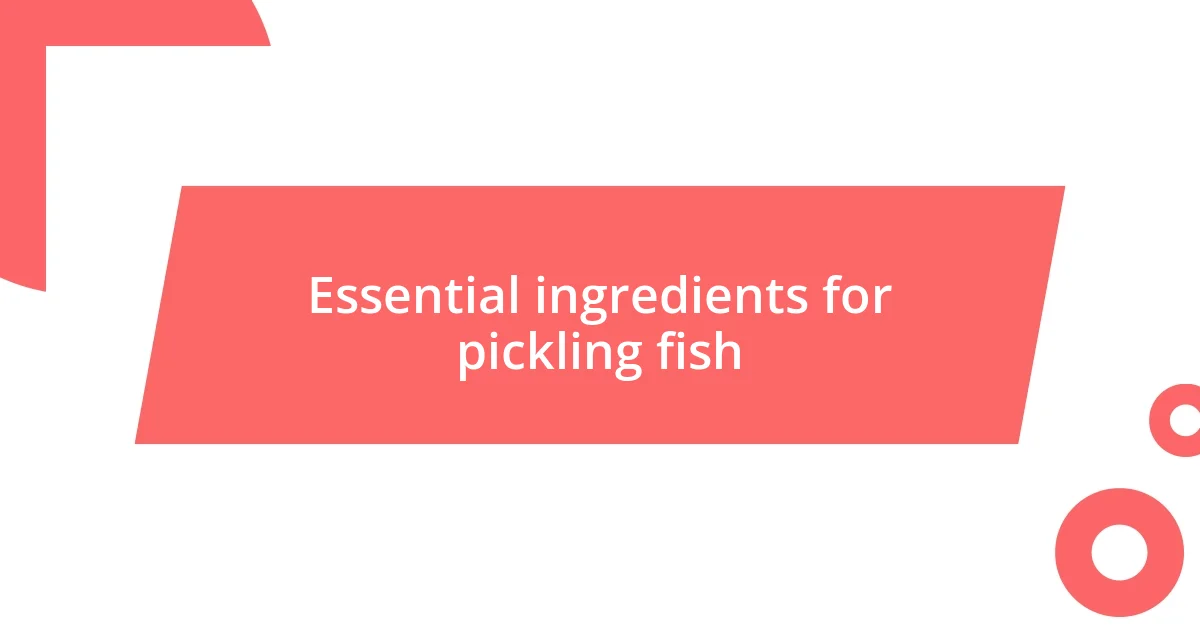Key takeaways:
- Pickled fish is a cherished culinary tradition that evokes memories and personal stories, with each family often having its own secret recipe.
- The essential ingredients for pickling fish include vinegar for preservation, salt for flavor enhancement, sugar for balance, and spices for complexity.
- Proper storage and creative serving ideas for pickled fish can enhance its flavors and elevate dishes, making it versatile for salads, pasta, or tacos.

Introduction to pickled fish
Pickled fish has a unique charm that transcends cultures and generations. There’s something magical about the way the briny, tangy flavors meld with the tender fish, creating a dish that not only tantalizes the taste buds but also evokes delightful memories. I remember the first time I tasted homemade pickled herring at my grandmother’s house – the flavors were so vibrant and rich that it felt like a warm hug, and I wondered how something so simple could hold such depth.
The art of pickling fish is more than just a preservation technique; it’s a culinary tradition that carries stories of family gatherings, fishing trips, and celebrations. Each family often has its secret recipe, incorporating special spices and methods that make their pickled fish uniquely theirs. Have you ever wondered what goes into the perfect brine? From vinegar to sugar and an array of spices, each ingredient plays a crucial role, and I’ve found that the journey of experimentation in the kitchen can lead to some of the most delightful discoveries.
As I dive into the world of homemade pickled fish, I find myself fascinated by its versatility. Whether paired with crisp bread, served alongside potatoes, or enjoyed straight from the jar, its presence adds a touch of nostalgia to any meal. What memories does pickled fish evoke for you? Each bite can open a door to the past, reminding us of cherished traditions and the people we love.

Essential ingredients for pickling fish
For pickling fish, the essential ingredients create the foundation for a mouthwatering dish. Vinegar is a must, as it not only adds acidity but also helps preserve the fish. From my experience experimenting with different types like apple cider or white vinegar, each brings its own unique character to the final flavor. I tend to lean towards apple cider vinegar when I want a slightly sweeter profile, which makes it an enjoyable choice for gatherings.
Next, we have salt and sugar, two power players in the pickling process. Salt not only enhances the fish’s natural flavors but also aids in firming up the texture. Sugar, on the other hand, balances the tartness of vinegar, making it essential to achieve the perfect harmony in taste. In my kitchen experiments, I’ve found that the right ratio of sugar to salt can transform the entire dish. Have you ever tried adjusting these amounts? It’s fun to discover how a little tweak can yield such varied results.
Lastly, spices lend their aromatic charm to pickled fish, elevating it to new heights. Common choices include dill, mustard seeds, and bay leaves. I remember a particularly delightful batch where I added a hint of crushed red pepper, giving the fish a subtle kick that pleasantly surprised my dinner guests. Exploring different spice combinations can turn the simple act of pickling into an exciting culinary adventure.
| Essential Ingredient | Purpose |
|---|---|
| Vinegar | Provides acidity and helps preserve fish |
| Salt | Enhances flavor and firms texture |
| Sugar | Balances acidity for a harmonious taste |
| Spices | Add complexity and unique flavors |

Step by step pickling process
The pickling process begins with preparing the fish, something I find quite ritualistic. Whether I’m filleting freshly caught herring or simply using store-bought varieties, I always take my time here to ensure everything is done right. It’s crucial to remove any bones and skin for a cleaner taste. Then, I give the fish a gentle rinse in cold water, which feels like washing away the stress of the day.
Here’s a step-by-step guide to streamline your pickling journey:
- Prepare the Fish: Fillet, debone, and rinse the fish.
- Make the Brine: Combine vinegar, water, sugar, and salt in a pot and bring it to a gentle simmer.
- Add Spices: Toss in your chosen spices to infuse the brine with flavor.
- Submerge the Fish: Place the fish into jars and pour the hot brine over it, ensuring it’s fully submerged.
- Seal and Refrigerate: Allow the jars to cool before sealing, then refrigerate for at least 24 hours, though I usually let mine marinate for a few days for deeper flavor.
As I meticulously layer the fish and brine, I can’t help but reminisce about my late uncle’s passion for pickling. He used to say that patience in the pickling process was as important as the ingredients themselves. And it’s true! Each moment spent waiting for those vibrant flavors to meld only adds to the anticipation. Trust me, the wait is worth every second!

Tips for flavoring and seasoning
When it comes to flavoring and seasoning your pickled fish, I can’t stress enough the importance of experimenting. I remember one summer, I decided to mix things up by adding fresh herbs like parsley and basil straight from my garden. The bright flavors made a huge difference, transforming the dish into a refreshing delight. Have you ever thought about what fresh herbs could do for your own recipes? They have that ability to elevate the subtle notes of vinegar and salt into something truly memorable.
Don’t shy away from tasting as you create. I always make it a point to sample the brine before pouring it over the fish. I recall a time when a touch more sugar turned a tangy mix into a beautifully balanced marinade, and my friends couldn’t get enough of it. It’s fascinating how our taste buds can guide us—what flavors are you curious about? Trusting your palate can lead to delightful surprises you might not have expected.
Lastly, consider layering your flavors. I like to add sliced onions or garlic cloves directly into the jars alongside the fish. One time, I let the onions steep for an extra day, and when I finally tasted the result, the sweetness mingled with the vinegar perfectly. It’s these little choices that personalize your pickling journey, turning a simple recipe into a reflection of your tastes. Have you ever thought about which ingredients you could layer together to create your signature flavor? The possibilities are endless!

Storing and serving pickled fish
When it comes to storing pickled fish, I’ve learned that proper refrigeration is key to maintaining its quality. I always make sure my pickled creations are kept in airtight jars to prevent any unwanted odors from mingling. It’s a bit like a treasure chest—sealing those flavors in makes the anticipation of tasting them later even more delightful! Have you ever eagerly opened a jar of pickled fish only to be greeted by a burst of robust scent? There’s something magical about that moment.
I generally keep my pickled fish in the fridge for up to two weeks, but I’ve noticed that the flavors get better with time—like a fine wine! Just the other day, I cracked open a jar that I had left for almost three weeks, and the taste was phenomenal. It had developed this rich complexity that I hadn’t anticipated. Have you thought about how time can transform your recipes? Sometimes, a little patience can yield mouthwatering rewards!
Serving pickled fish can be as simple or as elaborate as you want. I often enjoy it on a slice of crusty bread with a smattering of cream cheese; the combination is undeniably comforting. On special occasions, I’ve attempted to plate it beautifully with fresh garnishes, and I love how a bit of color can make the dish pop. What about you? Have you ever used your pickled fish as a start to an impressive appetizer spread? It not only looks inviting but adds a hint of homemade charm!

Creative recipes using pickled fish
One of my favorite ways to use pickled fish is in a vibrant salad. Imagine tossing together fresh greens, slices of avocado, and a handful of pickled fish, drizzled with a tangy vinaigrette. I remember making this for a summer picnic—everyone was surprised at how well the flavors synergized. Have you ever paired contrasting ingredients to create an unexpected delight? I found that the crunch of the salad perfectly complemented the tender fish, making each bite a burst of freshness.
Another delightful option is incorporating pickled fish into pasta dishes. A while back, I decided to try it in a creamy linguine, and the results were stunning! I sautéed garlic, added the fish, and just before serving, tossed in a splash of lemon juice. The way the flavors danced together reminded me of coastal dinners I’ve enjoyed abroad. It’s incredible how a simple addition can elevate a dish; have you ever thought about how pickled fish could transform your next pasta night?
For a unique twist, serving pickled fish on tacos has become a go-to in my kitchen. Just a few weeks back, I made some for a gathering, layering the fish with crunchy slaw and a zesty sauce. It was a crowd-pleaser! The bold flavors contrasted beautifully, bringing a fresh spin to a classic. Have you considered trying pickled fish in your taco creations? It’s such a fun way to experiment with flavors while keeping things light and refreshing.















